Sustaining the poultry production at its peak is one of the critical task for any poultry producer to optimize their operations and associated profitability. Out of the various factors that can influence poultry productivity, the significant one will be mycotoxins and its deteriorating effects on gut health and immunity of birds. These mycotoxins, particularly Aflatoxins, Ochratoxin A, Fumonisins, T-2 Toxin, & DON can have adverse effects on poultry depending on the contamination levels in raw materials and finished feeds. With the rising volatility in raw materials with respect to quality, supply and pricing, poultry producers are compelled to include alternative raw materials, consequently increasing the threat of mycotoxin incidences. High-fiber raw materials and grain by-products have proved to contain higher concentrations of mycotoxins as compared to their parent grains since mycotoxins tend to concentrate on outer portion of grains. In these scenarios, its crucial to understand the type of toxicity, the source of mycotoxins (which raw materials), its impact on animals and take corrective measures with respect to quality control and judicious inclusion of apt feed additives.
Acute and Chronic Toxicity
Acute toxicity with mycotoxins occurs when animals are exposed to higher concentrations of mycotoxins within a short time frame, like say, feeding of 250 ppb aflatoxin-contaminated feed to broilers. Acute toxicity is often easy to identify as they present themselves with clear and specific symptoms in poultry (aflatoxin, ochratoxin, T2 etc.). Chronic toxicity on the other hand is hard to diagnose due to multiple reasons like – no clear animal symptoms, low concentration of mycotoxins, masked mycotoxins, mycotoxin interactions, limited mycotoxin analysis etc. Chronic toxicity occurs when animal is exposed to lower level of mycotoxin or group of mycotoxins over a long period of time, say, 10 ppb of aflatoxins in laying birds over several weeks.
Both types of toxicity are harmful to animal performance, with the chronic been more detrimental, as they are hard to infer. Chronic toxicity may manifest itself through its impact on gut health and immunity system of birds, leading to symptoms like poor feed efficiency, wet litter, vaccine inefficacy, increased bacterial/viral infections etc. These symptoms are hard to be associated to mycotoxicosis, as they often could be a result of pathogenic infections or management issues also. Feed analysis performed in a proper manner, can be a way out to deal with chronic toxicity, which would then pave way to assess associated mycotoxin risks and manage/mitigate the risks accordingly.
Mycotoxins and gut health
Most mycotoxins compromise gut health (Table 1). They cause cellular damage to gut cells via increased pro-inflammatory cytokine secretion and protein synthesis inhibition effects. As a result of such effects, intestinal tight junction protein functions are compromised leading to
“leaky gut” (Fig. 1). This further leads to translocation of mycotoxins and pathogens into the blood stream, leading to further inflammation and the subsequent increased susceptibility to bacterial and viral infections.
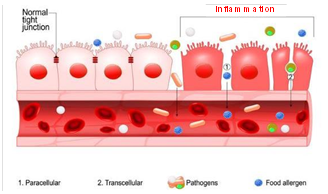
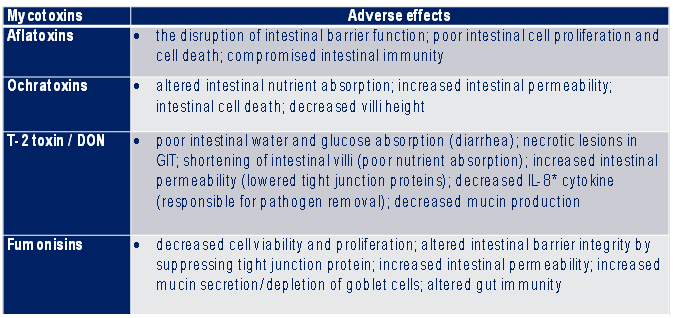
Mycotoxins and Immune response:
It is a well-recognized fact that most of the mycotoxins affect the immunity system of birds, reducing the bird’s capacity to fight infections, as shown below in Tables 2 and 3.
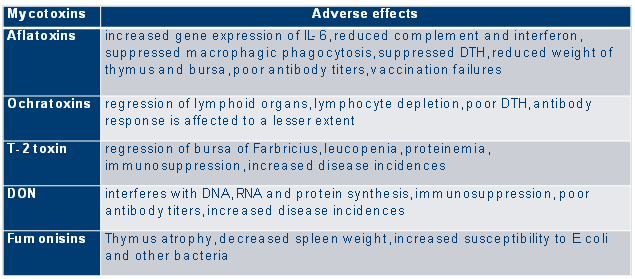
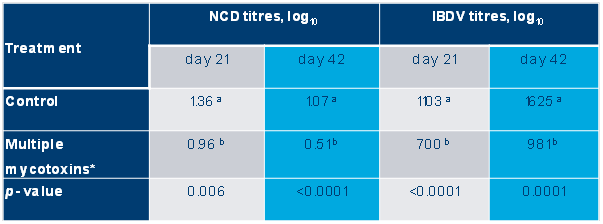
*- 250 ppb of AF, OTA and T2
Malathi et al., 2019
Mycotoxin mitigation strategy
As observed from above data, mycotoxins do have significant negative impact on gut health and immunity. Consequently, a mere mycotoxin binding strategy may not be enough to protect the birds. Additionally, there is the need of ingredients for improving immunity and gut health, along with protection against multiple mycotoxins. The multiple mycotoxin protection is a necessity as the feed is usually contaminated with more than one mycotoxin and a broad-spectrum solution will enable poultry producers to safeguard their business.
TOXO®-XL is a broad-spectrum mycotoxin risk management concept from Trouw Nutrition, that offers wholesome protection against mycotoxins in an integrated manner through three science-based modes of action. One of the modes of action is effective in reduction of mycotoxin bioavailability through high quality bentonite (smectite-based). The other mode of action is maintenance of intestinal epithelial integrity with the help of selected glucose biopolymers of yeast origin. The tight junction integrity is attained through the increased production of multi-protein complexes which inhibit the intercellular transport of toxins and pathogens into the blood circulation. Various trials with TOXO®-XL, have shown that it effectively reduces the mycotoxin-induced tight junction damage (Fig. 2) and improves villi height to crypt depth ratio (Fig. 3).
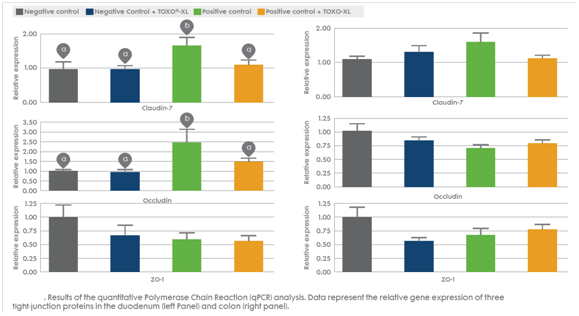
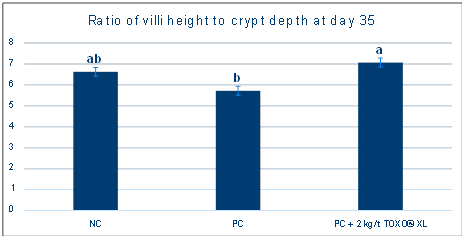
NC – negative control; PC: positive control – 6 ppm DON challenge
Lastly, TOXO®-XL modulates the immunity of birds through purified beta-glucans. Mycotoxins-induced immunosuppression can be due to various mechanisms, one of which is poor effector cell function of macrophages. Macrophages can recognize beta-glucans by their membrane receptors and get activated without causing negative effects such as inflammation, loss of appetite and poor growth. For superior activation and better immunostimulatory capacity, this activation requires exposed and intact beta-glucans that are extracted through specific processes. Exposed Beta-glucans selected in TOXO®-XL originate from the middle layer of cell walls of Saccharomyces cerevisiae, through enzymatic extraction. Unlike the traditional technique of using chemicals to expose Saccharomyces cerevisiae structure, this enzymatic technique ensures a maximum production of intact beta-glucans, to cater to better immune response and vaccine efficacy.
Conclusions
Presence of mycotoxins in feed and their accompanied risks are inevitable. Monetary losses due to harmful effects of mycotoxins, in both clinical and sub-clinical form, can be huge if not taken care of in a holistic way. Due emphasis needs to be placed in terms of stringent quality control measures of incoming raw materials, outgoing finished feed, optimal storage and logistics practices and adoption of broad-spectrum mycotoxin mitigation programs in feed. Effective mycotoxin binding along with technologies to improve animal intestinal integrity and immunity should be included as part of a total solution to combat multiple mycotoxin challenge.
For further information, kindly write to us at customercareindia@trouwnutrition.com or visit our website: www.trouwnutrition.in